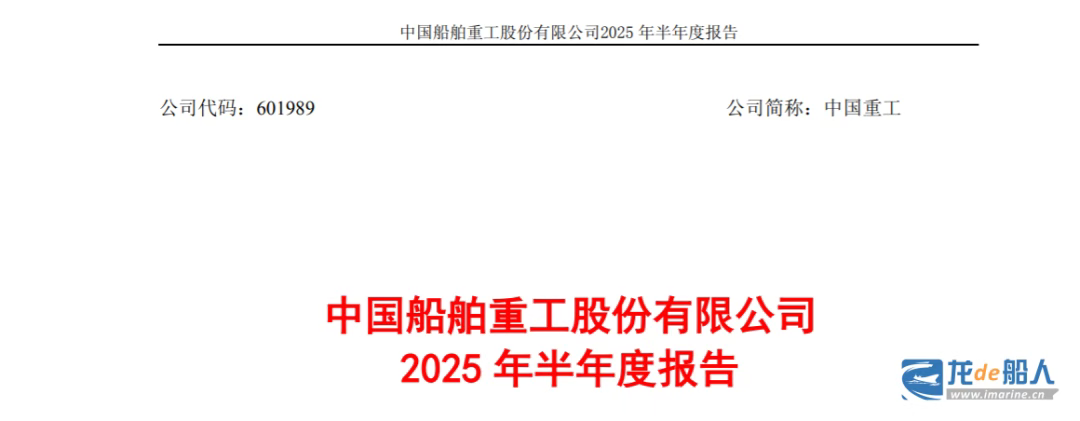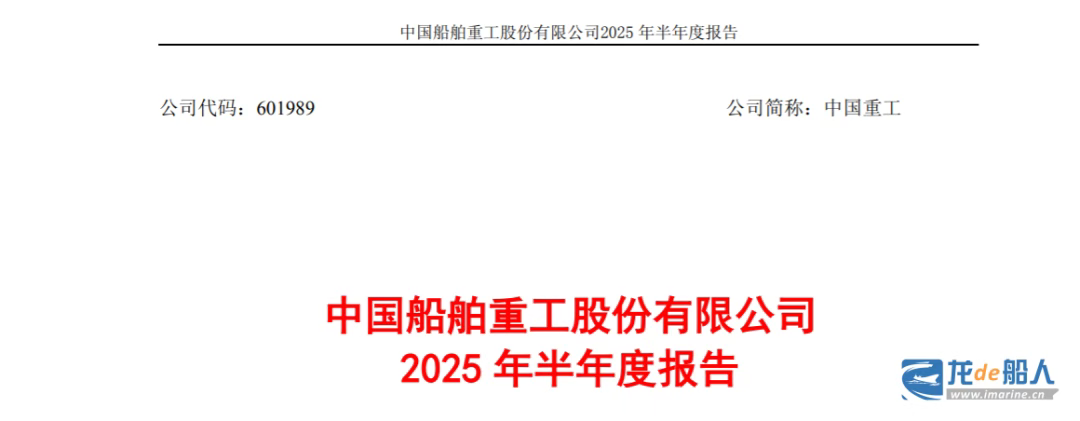On August 29, China State Shipbuilding Corporation Limited (hereinafter referred to as “CSSC”) and China Shipbuilding Industry Company limited (hereinafter referred to as “CSIC”) simultaneously released their 2025 Semi-Annual Reports.

The announcement disclosed that during the reporting period, CSSC’s market competitiveness significantly strengthened, achieving operating revenue of RMB 40.325 billion (approximately US$5.654 billion), representing a year-on-year increase of 11.96%. Of this, the shipbuilding, repair, and offshore engineering business generated operating revenue of RMB 38.669 billion (approximately US$5.421 billion), a year-on-year increase of 12.26%. Net profit attributable to shareholders of the parent company reached RMB 2.946 billion (approximately US$413 million), a year-on-year increase of 108.59%.
During the reporting period, CSSC’s total profit, net profit attributable to shareholders of the listed company and net profit attributable to shareholders of the listed company after deducting non-recurring gains and losses increased year-on-year, mainly because: the shipbuilding industry as a whole maintained a good development trend, and the company’s order backlog structure was upgraded and optimized; the prices of civilian ships delivered during the reporting period increased year-on-year, construction costs were properly controlled, and operating gross profit increased year-on-year; the operating performance of the company’s equity-holding joint ventures continued to improve, and the income from long-term equity investments accounted for using the equity method increased year-on-year.
In terms of order intake, during the first half of 2025, CSSC secured 59 commercial ship orders totaling 5.4398 million deadweight tons and valued at RMB 48.905 billion; ship repair contracts amounted to 130 ships worth RMB 1.117 billion; for offshore equipment, 2 ships/410,000 deadweight tons/RMB 2.956 billion; and for application industries, contracts worth RMB 1.569 billion. Among the newly secured ship orders, CSSC’s mid-to-high-end ships accounted for over 90%, while green ships constituted more than 50%.
As of June 30, 2025, CSSC’s cumulative order backlog comprised 333 merchant ships totaling 26.4911 million deadweight tons and valued at RMB 233.487 billion; 74 ship repair orders valued at RMB 766 million; offshore equipment contracts worth RMB 3.699 billion; and application industry contracts valued at RMB 2.11 billion.
During the reporting period, CSSC, anchored in its new development phase and adhering to the philosophy of green development, accelerated the optimization and iteration of its branded ships, vigorously pursued research into core proprietary shipbuilding technologies, and continuously strengthened its digital transformation. In the first half of the year, CSSC completed 748 patent applications, including 711 invention patents; secured 286 patent authorizations; and received 38 science and technology awards. CSSC achieved significant progress in cryogenic containment systems, AI-powered automated structural modeling and demodeling, a paperless shipbuilding platform, a ship production resource management and control platform, and the application of rotor duct energy-saving technology, accelerating the transformation of its products towards high-end, green, and intelligent optimization.
CSSC closely focuses on the strategic layout of deep-sea science and technology, deeply cultivates high-end ship fields such as deep-sea marine equipment, fully enhances the R&D capability of deep-sea equipment, and masters core construction technologies. In the first half of the year, Waigaoqiao Shipbuilding undertook a 300,000-ton FPSO, and Guangzhou Shipyard International undertook a 70,000 DWT semi-submersible ship, which further strengthened the company’s competitiveness in the deep-sea development technology and equipment market and helped build a highland for the deep-sea science and technology industry. CSSC has conducted special research on relevant advantageous products and core technology reserves, explored the intelligent development direction of the ship and marine industry, analyzed the current development situation of the ship market, as well as the development direction, future trends and technological innovation of deep-sea science and technology, so as to enhance the capital market’s recognition of the company’s strategic value.
To implement the guiding principles of the CPC Central Committee and the State Council on deepening SOE reform and the major decisions and deployments of the CSSC, the CSSC has proactively and fully advanced all milestones since the launch of the major asset restructuring of CSIC through a share swap and absorption merger in September of last year. Currently, the CSSC is accelerating the implementation of the share swap and other related work.
CSSC’s primary businesses include shipbuilding (military and civilian), ship repair, offshore engineering, and electromechanical equipment. As a global partner in the shipping industry, the company focuses on value creation, insists on innovation-driven development, and continuously promotes the transformation and upgrading of its business towards high-end, green, and intelligent operations. CSSC’s core businesses are comprised of its four subsidiaries: Jiangnan Shipyard, Waigaoqiao Shipbuilding, CSSC Chengxi Shipyard, and Guangzhou Shipyard International.
CSIC reported revenue of RMB 32.621 billion (approximately US$4.573 billion) and secured orders for 47 merchant ships.

According to the announcement, CSIC is a leading publicly listed shipbuilding company specializing in R&D, design, and manufacturing. Its primary business covers five key sectors: marine defense and development equipment, marine transportation equipment, deep-sea equipment and ship repair and conversion, shipbuilding equipment and electromechanical equipment, strategic emerging industries, and other sectors. CSIC owns internationally renowned modern shipbuilding companies such as Dalian Shipbuilding Industry Corporation (DSIC), Wuchang Shipbuilding Industry, and Beihai Shipbuilding.
During the reporting period, CSIC capitalized on industry trends in the shipbuilding sector, further leveraging its strengths in batch production of mainstream ships. The company intensified lean management practices, deepened cost control measures, and focused on enhancing operational efficiency and profitability. The company’s civilian ship production has increased significantly, with corresponding growth in operating revenue and a marked improvement in business performance compared to the same period last year.
In the first half of 2025, CSIC achieved operating revenue of RMB 32.621 billion (approximately US$4.573 billion), a year-on-year increase of 47.56%; net profit attributable to shareholders of the listed company was RMB 1.745 billion (approximately US$245 million), a year-on-year increase of 227.07%; net profit attributable to shareholders of the listed company after deducting non-recurring gains and losses was RMB 1.473 billion (approximately US$207 million), a year-on-year increase of 231.91%.
During the reporting period, CSIC accelerated the production and operation of civil ships. As of the end of June 2025, CSIC held 229 orders with a total deadweight tonnage of 34.9392 million, representing a 15.3% increase in deadweight tonnage compared to the end of the previous year. Among the order backlog, the proportion of green ships and mid-to-high-end ships continued to rise. In the first half of the year, CSIC continued to make efforts around its main built ship types to secure new ship orders. In the first half of the year, it newly received and effective civil ship orders totaled 47 ships, with 8.3826 million deadweight tons and 1.6367 million compensated gross tons. The new orders are scheduled until 2029. Among the new orders, green ship types accounted for 35.19%, and both the proportion of main built ship types and batch orders exceeded 90%.
During the reporting period, DSIC secured numerous orders for VLCCs, 115,000 DWT liquid ammonia dual-fuel tankers, and 175,000 cbm green dual-fuel LNG carriers, further increasing its market share in key shipbuilding categories. Wuchang Shipbuilding Industry, capitalizing on demand for oil tankers, secured numerous orders for 25,900 DWT stainless steel chemical tankers. Beihai Shipbuilding secured consecutive orders for 210,000 DWT LNG dual-fuel bulk carriers and 325,000 DWT methanol dual-fuel ore carriers, maintaining its leading orderbook for these 210,000 DWT bulk carriers and 325,000 DWT ore carriers.
In the first half of 2025, CSIC focused on construction cycle management and strengthened production planning control. Multiple ships were delivered in batches or ahead of schedule, with steady improvements in production and construction efficiency. A total of 34 merchant ships were delivered, amounting to 3.7391 million deadweight tons (a 34.8% increase year-on-year).
During the reporting period, DSIC completed all milestones for its LNG carriers under construction on schedule or ahead of schedule. It delivered a 16,000 TEU dual-fuel container ship, completing a combined oil and gas sea trial and completing the construction of large container ships on its small-dock production line. All of its dual-fuel large containerships under construction were delivered ahead of the annual schedule. A 115,000 DWT product tanker was delivered 118 days ahead of the contract period. Beihai Shipbuilding delivered six 210,000 DWT series ammonia-ready bulk carriers, further shortening the delivery cycle compared to 2024.
In the ship repair and conversion sector, CSIC’s ship repair business maintained overall stability in the first half of 2025, with new contracts valued at RMB 1.713 billion. During the reporting period, CSIC completed 254 repair and conversion ships, maintaining a robust conversion business.
According to the semi-annual reports of two listed shipbuilding enterprises, in the first half of 2025, China’s shipbuilding completions reached 24.6396 million deadweight tons, with new orders totaling 26.3221 million deadweight tons, based on Clarkson data. As of the end of June, China’s order backlog stood at 260.65 million deadweight tons.
From the structure of new ship orders, China secured 13.78 million deadweight tons of new container ships, accounting for 52.35% of the total; 7.30 million deadweight tons of new bulk carriers, representing 27.75% of the total; New oil tanker orders totaled 2.7654 million deadweight tons, accounting for 10.51% of the total; New orders for other ships reached 2.4720 million deadweight tons, accounting for 9.39% of the total.


